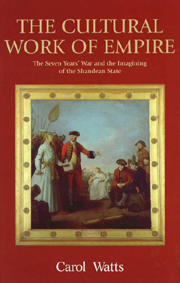Book contents
- Frontmatter
- Contents
- Acknowledgements
- List of Illustrations
- Abbreviations
- INTRODUCTION: THE CULTURAL WORK OF EMPIRE
- 1 LUNACY IN THE COSMOPOLIS (1759): EXPANSION AND IMPERIAL RECOIL
- 2 PATRIOT GAMES: MILITARY MASCULINITY AND THE RECOMPENSE OF VIRTUE
- 3 PRICKSONGS IN GOTHAM: OR, THE SEXUAL OECONOMY OF STATE IMAGINING
- 4 FRIENDSHIP, SLAVERY AND THE POLITICS OF PITY, INCLUDING A VISIT FROM PHILLIS WHEATLEY
- 5 WOMEN'S TIME AND WORK-DISCIPLINE: OR, THE SECRET HISTORY OF ‘POOR MARIA’
- 6 ‘BRAMIN, BRAMINE’: STERNE, ELIZA DRAPER AND THE PASSAGE TO INDIA
- 7 CONCLUDING ALONG SHANDEAN LINES
- Bibliography
- Index
1 - LUNACY IN THE COSMOPOLIS (1759): EXPANSION AND IMPERIAL RECOIL
Published online by Cambridge University Press: 12 September 2012
- Frontmatter
- Contents
- Acknowledgements
- List of Illustrations
- Abbreviations
- INTRODUCTION: THE CULTURAL WORK OF EMPIRE
- 1 LUNACY IN THE COSMOPOLIS (1759): EXPANSION AND IMPERIAL RECOIL
- 2 PATRIOT GAMES: MILITARY MASCULINITY AND THE RECOMPENSE OF VIRTUE
- 3 PRICKSONGS IN GOTHAM: OR, THE SEXUAL OECONOMY OF STATE IMAGINING
- 4 FRIENDSHIP, SLAVERY AND THE POLITICS OF PITY, INCLUDING A VISIT FROM PHILLIS WHEATLEY
- 5 WOMEN'S TIME AND WORK-DISCIPLINE: OR, THE SECRET HISTORY OF ‘POOR MARIA’
- 6 ‘BRAMIN, BRAMINE’: STERNE, ELIZA DRAPER AND THE PASSAGE TO INDIA
- 7 CONCLUDING ALONG SHANDEAN LINES
- Bibliography
- Index
Summary
Whatever interest we take in the fortune of those with whom we have no acquaintance or connexion, and who are placed altogether out of the sphere of our activity, can produce only anxiety to ourselves, without any manner of advantage to them. To what purpose should we trouble ourselves about the world in the moon?
Adam Smith, The Theory of Moral Sentiments (1759)The rest I dedicate to the MOON, who, by the bye, of all the PATRONS or MATRONS I can think of, has most power to set my book a-going, and make the world run mad after it.
Laurence Sterne, Tristram Shandy (1759)The errant trajectories of people and things that shape the Shandean universe testify to a widespread form of ‘lunacy’ characteristic of the imperial project in mid-century Britain. It was not only philosophers who reflected on the troubling presence of the ‘world in the moon’, and the potential affiliations with the fortunes of unknown others who inhabited it. These were flows which traversed the globe, connecting lives and territories in previously unimaginable and accidental ways. If the experience of empire itself was not new in the 1760s, though the reach of British power was unparalleled, its administration and governance now required new forms of cultural labour which in their imaginative projection began to unsettle the boundaries of ‘home’ in distinctive ways. For all the craziness of attempting to chart and understand the ‘tentacular’ movement of conquest and commerce, it proved a sober enterprise in orientation even in the most domestic of circumstances.
- Type
- Chapter
- Information
- The Cultural Work of EmpireThe Seven Years' War and the Imagining of the Shandean State, pp. 28 - 64Publisher: Edinburgh University PressPrint publication year: 2007



